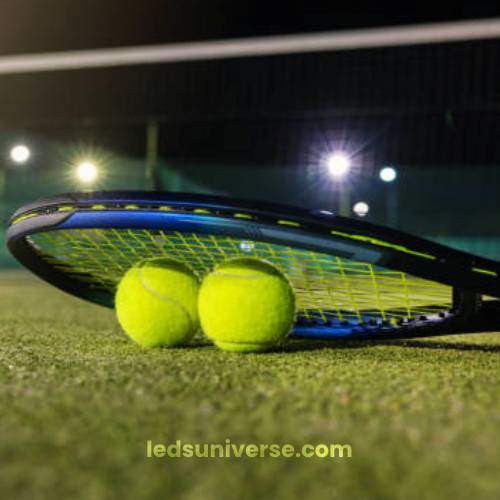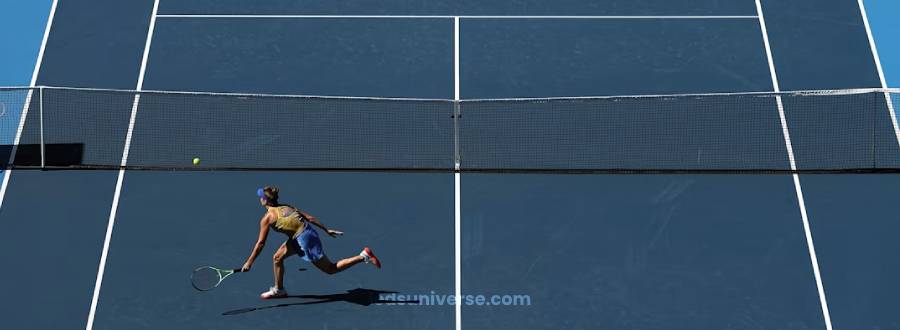From the classic glow of Metal Halide to the energy-savvy brilliance of LEDs, each lighting type brings its own unique flair to the court. Discover how each option stacks up in terms of brightness, color rendering, and efficiency to help you find the perfect illumination for your tennis matches. Let’s illuminate your path to the ideal tennis court setup!
Tennis is a fast-paced sport where players rely on clear visibility to track the movement of a small, high-speed ball. Proper lighting is essential for both players and spectators to follow the game smoothly, enhancing the overall experience. Without adequate lighting, especially in low-light conditions such as evening matches or cloudy days, it becomes difficult to maintain optimal performance, and the risk of injury may increase. Well-designed tennis court lighting extends playing hours and ensures that games can continue in the evening, making the courts more accessible and profitable for sports clubs and venues.
Reach out for free lighting consultation
Table of Contents
ToggleThere are three main types of lighting used for tennis courts: Metal Halide (MH), High-Pressure Sodium (HPS), and LED. Each of these types comes with its own set of characteristics, advantages, and disadvantages.
Metal Halide lighting has long been a popular choice for tennis courts due to its high lumen output and good color rendering. These lights provide a bright and natural light, closely resembling daylight, which is favorable for sports that require fast reflexes and hand-eye coordination. However, they come with drawbacks such as longer warm-up times, higher energy consumption, and a relatively shorter lifespan compared to newer technologies.
High-Pressure Sodium (HPS) lighting, while energy-efficient, tends to produce a yellow-orange light that can make it difficult for players to clearly see the tennis ball. This type of lighting is often more suitable for general outdoor areas rather than for sports like tennis, where sharp visibility is crucial. Though they last longer than Metal Halide lights, their color rendering capabilities are inferior, making them less ideal for tennis courts.
LED lights are becoming the standard for tennis court lighting due to their many advantages. They are energy-efficient, offer instant-on functionality, and have an extremely long lifespan—often surpassing 80,000 hours. LEDs also allow for better control over lighting distribution, making it easier to achieve uniform illumination across the court. Although the initial investment for LED lighting is higher, the long-term savings in energy costs and reduced maintenance make it a cost-effective solution over time. Additionally, the use of optics in LED floodlights allows for precise beam angles, reducing light spillage and glare, which is crucial in ensuring that players are not distracted or dazzled during the game.

When designing lighting for a tennis court, several key factors must be considered to ensure that the players have adequate visibility and that the lighting system is efficient and effective.
Uniform lighting is critical in a sport like tennis, where the ball moves rapidly across the court. Lighting should be evenly distributed to avoid any dark spots that could affect gameplay. Achieving proper uniformity requires strategic placement of light fixtures, typically around the perimeter of the court, and careful selection of beam angles to ensure even illumination. The brightness, or lux level, also varies depending on the level of play, with professional courts requiring higher lux levels (typically around 750 lux) compared to recreational courts, which may only need 300-500 lux.
Another important consideration is controlling glare and light pollution. Excessive glare can interfere with the players’ vision, making it difficult to track the ball, especially during fast volleys. Fixtures should be equipped with glare shields or be mounted in such a way that the light is directed downwards and does not spill into the players’ eyes. For outdoor courts, minimizing light pollution is essential to avoid disturbing nearby residential areas. LED lights are particularly effective in this regard, as their focused beam angles reduce the spread of light beyond the playing area.
For outdoor courts, poles are typically placed 8-12 meters high around the court’s perimeter. Common configurations include using four poles near the corners of the court or six poles with additional fixtures located near the sides of the net. Proper pole placement helps in achieving uniform lighting across the court and ensures that the light is not obstructed by players or other objects.
The design, installation, and overall lighting requirements vary significantly between the two environments, primarily due to differences in exposure to the elements, ceiling heights, and surrounding spaces. Both indoor and outdoor courts demand solutions that address visibility, safety, and performance while minimizing issues such as glare and shadows.
Indoor tennis courts typically utilize ceiling-mounted lighting systems to illuminate the playing area. The height and architecture of indoor spaces can present challenges in achieving uniform light distribution. Since ceilings are often uneven or of varying heights, light fixtures must be meticulously arranged and adjusted to provide even illumination across the court. This prevents the formation of dark spots or shadows that can hinder gameplay.
A popular approach for indoor courts is to employ indirect lighting systems. This involves positioning lights so that their beams reflect off the ceiling, creating a softer, diffused light that eliminates harsh glare and improves player visibility. Indirect lighting also contributes to a more comfortable environment by reducing eye strain during long games or tournaments. LEDs have become the preferred choice for indoor tennis court lighting due to their energy efficiency, ability to deliver bright, focused light, and low heat emission. In enclosed spaces, managing temperature is crucial, and LEDs are ideal since they do not generate excessive heat compared to traditional lighting options.
Outdoor tennis court lighting presents a unique set of challenges. The fixtures need to be designed for exposure to a variety of weather conditions, including rain, wind, and extreme temperatures. As such, outdoor lighting systems must prioritize durability and resilience, ensuring long-lasting performance even in harsh climates. Floodlights are commonly used for outdoor tennis courts and are mounted on tall poles around the perimeter to provide ample coverage of the playing area. These fixtures must be installed at optimal heights and angles to prevent uneven lighting or dark zones on the court.
One of the primary concerns for outdoor court lighting is minimizing light spillage into adjacent areas, such as nearby residential neighborhoods or roadways. Excessive light pollution can be a nuisance, and regulations often dictate strict limits on how much light can escape from the immediate vicinity of the court. LED lighting solutions with directional optics have become increasingly popular for outdoor courts. These specialized optics focus the light precisely where it’s needed, reducing glare for players and minimizing spillage into surrounding areas. In addition to their precise light distribution, LEDs are known for their weather resistance and ability to withstand the rigors of outdoor use. Their robust construction makes them particularly well-suited for environments where exposure to wind, moisture, and temperature fluctuations is a constant factor.

The lighting requirements for tennis courts vary depending on the level of competition and whether the court is used for professional matches or recreational play. These requirements are divided into three classes:
| Class | Description | Lux Levels | Key Considerations |
|---|---|---|---|
| Class I | Professional Competition | 500 – 750 lux | High uniformity, minimal brightness variation, suitable for tournaments and high-level play. |
| Class II | Club and Regional Competitions | 300 – 500 lux | Moderate uniformity, glare control, suitable for regional competitions and club matches. |
| Class III | Recreational Play and Training | 200 – 300 lux | Adequate brightness, basic uniformity, suitable for casual and recreational use. |
For professional tournaments and high-level competitions, the lighting must be top-notch to ensure that both players and spectators have a clear view of the game. The lux levels for Class I courts typically range from 500 to 750 lux, depending on the size of the court and the level of play. The lighting must also be uniform, with minimal variation in brightness across the court.
For regional competitions or local club matches, the lighting requirements are slightly less stringent than for professional games, with lux levels ranging from 300 to 500. However, uniformity remains a key consideration, and glare must be minimized to ensure optimal playing conditions.
Courts used for recreational play or training purposes generally have the least demanding lighting requirements, with lux levels around 200 to 300. Although these courts do not need the same level of precision in lighting design, it is still important to maintain adequate brightness and uniformity to ensure an enjoyable playing experience.
When comparing LED lighting to traditional options like Metal Halide and High-Pressure Sodium, LEDs stand out in several key areas.
LED lights are significantly more energy-efficient, converting up to 95% of their energy into light compared to 60-80% for traditional lighting options. This translates into substantial energy savings over time.
The lifespan of LED lights far exceeds that of Metal Halide and High-Pressure Sodium lamps. With lifespans of up to 80,000 hours, LEDs require less frequent replacement, reducing maintenance costs and downtime.
LEDs provide better light quality, offering high color rendering and more uniform illumination. They also start up instantly, unlike Metal Halide and High-Pressure Sodium lamps, which have longer warm-up times.
LED floodlights for tennis courts are designed to be low-maintenance and long-lasting. They are resistant to harsh weather conditions and can withstand extreme temperatures. With proper maintenance, such as occasional cleaning to remove dust and dirt, LED lights can operate efficiently for many years, providing consistent illumination without the need for frequent replacements. Moreover, many LED lighting systems come with warranties of up to five years, giving court owners peace of mind.
In conclusion, whether for indoor or outdoor use, the importance of installing adequate tennis court lighting cannot be overstated. It not only enhances gameplay and safety but also extends the usability of courts well into the evening hours, offering a profitable solution for facility owners.
With the fast-paced nature of tennis, ensuring that the ball is visible at all times is crucial, and this can only be achieved with the correct lighting solutions. Whether for an indoor or outdoor court, the design considerations must meet specific lux levels, uniformity, and pole positioning to avoid glare and shadows that can disrupt play.
LED lighting, with its energy efficiency, durability, and long lifespan, has become the preferred solution for tennis courts over traditional options like Metal Halide or High-Pressure Sodium lamps. While the initial investment might be higher, the long-term savings in energy costs and minimal maintenance make LEDs the most cost-effective option in the long run. Additionally, well-lit courts extend playtime into the night, making the facility more usable and profitable.